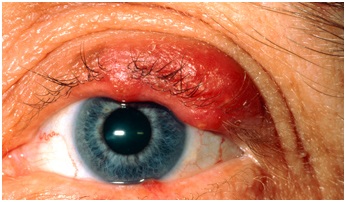A stye is a small, painful lump (cyst) that develops on the inside or outside of the eyelid.
Because a stye is usually caused by a bacterial infection, a stye is sometimes called an infectious cyst of the eyelid.
The medical name for a stye is hordeolum.
Styes often affect one eye, but sometimes a stye can develop in both eyes, or more than one stye can develop in one eye.
This article will discuss the following:
Symptoms of a stye
Types of styes
Causes of a stye
Treatment of a stye
When to see a doctor
Complications of a stye
Symptoms of a stye
The main symptoms of a stye include:
A painful yellow lump in or on the eyelid
Redness of the eye or eyelid
In some cases, tearing
Styes often heal without any specific treatment, especially after the stye has opened and the pus has drained.
Do not try to drain the stye yourself. If the stye is painful and the eyelid is very swollen, be sure to see a doctor.
Types of styes
There are generally two types of styes:
External stye (external hordeolum) - a swollen lump on the edge of the eyelid that may become a pus- filled spot and is tender and painful to the touch or any contact.
Internal stye (hordeolum interna) - A swollen lump inside the eyelid that is often less sensitive to touch than external styes.
Causes of styes
Styes are usually caused by a staphylococcal infection. Staphylococcus bacteria usually live on the skin without causing any problems.
External styes
Styes that develop on the outside of the eyelid can be caused by one of the following infections:
Eyelash follicle - Eyelash follicles are tiny pores in the skin from which eyelashes grow.
Zeis gland - This gland is attached to the eyelash follicle and produces an oily substance called sebum; sebum keeps the eyelashes from drying out by providing them with enough oil.
Moll's apocrine gland - This sweat gland empties into the eyelash follicle and prevents the eyes from drying out.
Styes
Styes occur when the meibomian glands become infected. These glands are located on the eyelids and produce an oily fluid that makes up part of the eye's tears.
If the meibomian gland becomes blocked, a cyst may form, which can become infected over time.
Blepharitis (eyelid swelling)
Sometimes, an infection of the eyelid follicle can be a complication of blepharitis (eyelid swelling). Symptoms of blepharitis include:
Inflamed, red, and swollen eyelids
Burning or painful eyes
Dandruff
Itchy eyelids
Blepharitis can be a complication of rosacea (a skin condition that commonly affects the skin on the face).

Styes Treatment
Most styes resolve without specific treatment within 1 to 3 weeks. However, the following treatments can be effective in reducing symptoms.
Warm compress
For a warm compress, you can soak a thin cloth in hot water, then wring it out and place the warm, damp cloth over the eye with the stye.
Be careful not to use very hot water, especially for children.
You should:
Place the warm compress on the affected eye for 5 to 10 minutes.
Gently massage the area.
Repeat this three to four times a day until the stye is gone or the pus is drained.
The heat from the warm compress will help drain any pus. Your stye symptoms should improve quickly.
You should also keep the area around your eyes clean and free of discharge.
Regular, daily use of warm compresses can help prevent the stye from forming again in the first place.
Painkillers
If the stye is painful, taking painkillers such as paracetamol or ibuprofen can help reduce the pain.
Always read the instructions on the medicine leaflet to make sure that the medicine is not harmful to your current condition and always use the correct dose.
Other eye conditions
If you have other conditions that are making the stye worse, your doctor may prescribe a separate medicine for that condition or recommend a different treatment for your current condition.
For example, if you have these conditions:
Conjunctivitis – a short course of antibiotic ointment may be prescribed.
Blepharitis – your doctor may ask you to take better care of your eyes and may recommend using cotton wool to clean and rinse the eyelid margin.
Antibiotics are not usually prescribed to treat stye, as their effectiveness has not been proven. Stye usually gets better on its own.
When should you see a doctor?
If you have tried the above, but your stye hasn't improved, you should see a doctor.
Be careful not to pull out your eyelashes or try to drain the stye yourself.
Referral
If you have a meibomian cyst (a cyst on the inside of your eyelid) and it is large or painful, your doctor may refer you to an eye specialist.
Your eye specialist may make a small incision in the cyst to drain the pus.
Complications of a stye
Complications of a stye are uncommon and are rarely serious.
Meibomian cysts
Meibomian cysts (chalazions) are usually painless unless they become infected. If they are painful, you may need to use antibiotics (in the form of an ointment).
Use warm compresses (as mentioned above) can help these cysts disappear. However, many of these cysts usually heal on their own.
Rarely, these cysts do not resolve on their own. In this case, your doctor will drain them surgically under local anesthesia.
Preseptal cellulitis
If the infection spreads to the tissues around the eye, preseptal cellulitis may develop.
Preseptal cellulitis is an infection of the skin layers around the eye that causes the eyelids to become red and itchy and is usually treated with antibiotics.